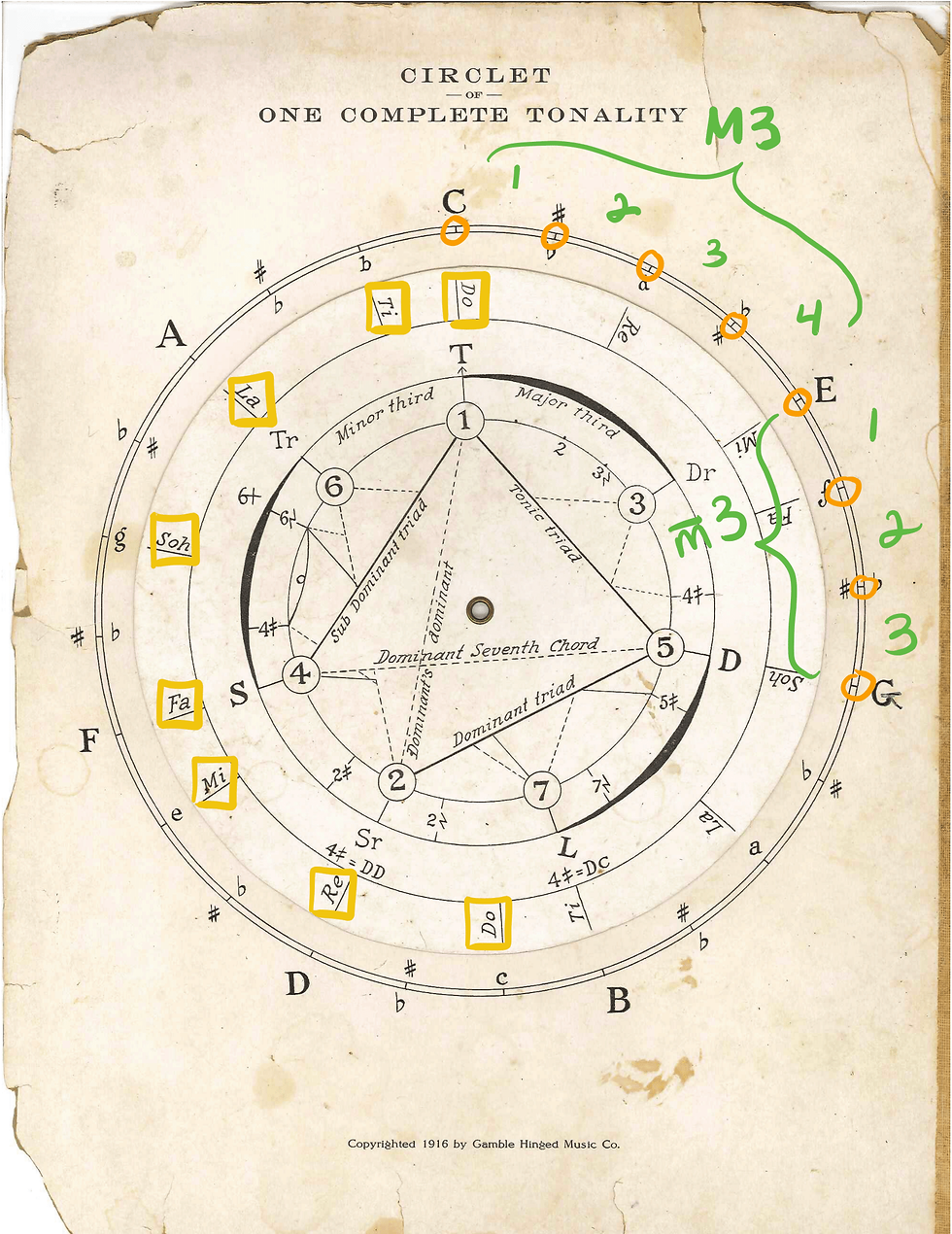A Music Theory Artifact!
- Christine Boone
- Oct 7, 2016
- 4 min read
*Disclaimer: This post is not about mashups. But this is just TOO COOL not to write about!
A couple of weeks ago, a student approached me and told me that he found some sort of antique music theory diagram in his basement. He tried to describe it to me, but he didn't really understand it; this is his first semester studying music theory. However, he offered to bring in the item for me to look at it, and I want to take some time to describe it here. It's a supplement to a music theory textbook from 1916, and the front and back sides are shown here:


There is one part of the chart that rotates: the outermost circle with letter names stays stationary, while the entire inner part of the circle (from the solfege syllables inward) rotates around the center. The way it's pictured above lines C up with Do, so that we can investigate the rest of the chart from the perspective of C major.
Working Inward from the Outermost Circle:

While each of the 12 pitch classes is represented on the outer circle by lines (circled in orange), the capital letters are arranged in a circle of thirds (C - E - G - B - D, etc.) so that the user can easily construct triads. The number of half steps between each third (marked in green) lets the student see the size difference between major and minor thirds.
Moving inward, the next circle consists of diatonic solfege syllables (in yellow squares) that can be rotated to match up to any major scale. The distance between the syllables (half or whole step) is easily visible. Finally, because the outer circle is arranged in thirds, the entire major scale appears twice if you follow the entire circle around.

The letters marked in purple signify the tonal functions of those scale degrees: Tonic, Dominant, Leading Tone, and Subdominant. The ones marked in blue signify the same functions (minus leading tone) in the key of the relative minor. Tr = Tonic of the Relative minor; Dr = Dominant of the Relative minor; Sr = Subdominant of the Relative minor. Finally, the "6+" in green marks the scale degree that an augmented sixth chord is built on. The parts circled in red, however, proved to be a bit harder to decipher. The symbol ≠ seems to be another way to write a sharp. I deduced that "4≠ = DD" probably
means that a triad built on Re and including scale degree #4 is the Dominant of the Dominant. In other words, Re - Fi - La = V/V. "4≠ = Dc," therefore, must symbolize the scale degree that V/V in the relative minor is built on. In A minor, a triad build on B with scale degree #4 (D-sharp) is the Dominant of the Dominant. The point of lingering confusion is the "c" in the symbol. I welcome anyone who has studied historical notation to let me in on the secret! Comment on this post or message me, please!

Continuing to move inward, we see in yellow that the distance between the tonic and the mediant is a major third, while the distance between the tonic and the
submediant is a minor third. In the same manner that ≠ represents a sharp, ϟ represents a flat. Various chromatic pitches are notated in this manner and marked in orange, making it easy to find them when writing secondary dominants, Neapolitan chords, etc. The mode mixture mediant is also represented. Finally, the distance between #4 and b6 is specified as a diminished third and marked in green.

The innermost part of the circle illustrates how to spell triads on different scale degrees. I've marked the way that the tonic, subdominant, and dominant triads are laid out in purple, red, and blue, respectively. The straight lines represent the boundary interval of the triad, and the third can be found by following the arc around the circle.

As you can see from the next diagram, the dominant triad can easily become a dominant seventh chord with the addition of scale degree four (shown in blue). I've also outlined the dominant's dominant (V7/V) in green. Remember that the mediant of that chord is #4 (marked in yellow).

The final diagram shows the way that any diatonic triad can be found by following the straight lines between boundary intervals and tracing the arc to find the third. I've shown the ii, iii, and vi chords here, in orange, red, and blue, respectively.
From a pedagogical perspective, I wonder how useful early twentieth-century music students found this chart. A negative factor, I think, is the sheer amount of information on it. The various layers of circles show the interrelated nature of triads, scales, and relative keys, but it has been my experience that students tend to panic when too much information is thrown at them all at once. It also took a fair amount of decoding. Would it be faster to memorize the way that the subdominant triad is spelled than to look it up on this device? Regardless, what a great find! Music students, and fellow theorists, let me know your thoughts!



Comments